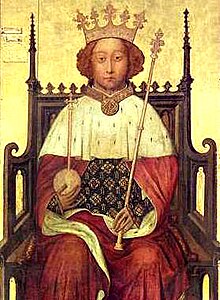20 July 1398: The Battle of Kellistown/ An Cath Cell Osnadha was fought on this day. The battle was fought between the forces of the O’Byrnes and O’Tooles, and the English of Leinster led by Roger Mortimer, the 4th Earl of March.
A battle was given to the English by O'Byrne and O'Toole, in which the Earl of March was slain, and the English were slaughtered.
Annals of the Four Masters
The O’Byrnes and O’Tooles were surrogates for Art Mac Murrough Cavanagh who was the most powerful Chieftain in Leinster and recognised as a King amongst his own people. He used them to fight a proxy war against the English and thus avoid a complete break with them. Kellistown is situated in County Carlow between the towns of Carlow and Tullow.
"Here fell the heir presumptive to the English crown, whose premature removal was one of the causes which contributed to the revolution in England a year or two later."
Mortimer had been created the King of England’s Lieutenant in Ireland in 1396 and held this position until the Irish killed him. His body was cut to pieces during the battle but whether this as a result of combat or mutilation after his death is not recorded. Curiously enough he had decided to engage in the combat dressed in the Irish style - that is without body armour. There was at least enough of him remaining for his corpse to be brought back home to England where he was interred amongst his own people in Wigmore Abbey, Herefordshire.
Mortimer was none other than an heir to the Throne of England. He was also dignified with the titles ‘Earl of Ulster’ and ‘Lord Of Connaught’. Ironically he was a direct descendant of Aoife Murchada, whose father had let the English in. Thus he was a distant relation of his nemesis Art Mac Murrough Cavanagh! However the unstable & paranoid King Richard II of England had ordered his arrest just after this engagement[27 July] but the news had not reached England before his death in battle. With him dead then the primary candidate to succeed the childless Richard became Henry Bolingbroke whom the King had sent into exile.
Richard was so concerned by the news from Ireland that his Authority had been so flouted and decided to settle matters once and for all with Art Mac Murrough who had submitted to his Rule when Richard had last campaigned here in 1394. But his departure from his own Country in the following years of 1399 cost him his Kingdom as his domestic enemies took the opportunity to topple him from his throne. On return in the month of August he was compelled to give up his crown and submit to the advances of his cousin, Henry of Bolingbroke who had returned and risen in revolt.
Henry was crowned King in Westminster Abbey on 13 October and Richard was now his prisoner. An embarrassment to the new King Henry IV he was allowed to wither away in captivity in Pontefract Castle in Yorkshire and ‘died’ (probably from deliberate starvation?] in early 1400.
An Cath Cell Osnadha was thus a battle of great importance in the history of two countries – England and Ireland - as it was a catalyst for a series of events that led to the Downfall of a Monarch who claimed to be both ‘King of England’ and ‘Lord of Ireland’ - claims that at the end of the day he found impossible to maintain.

No comments:
Post a Comment